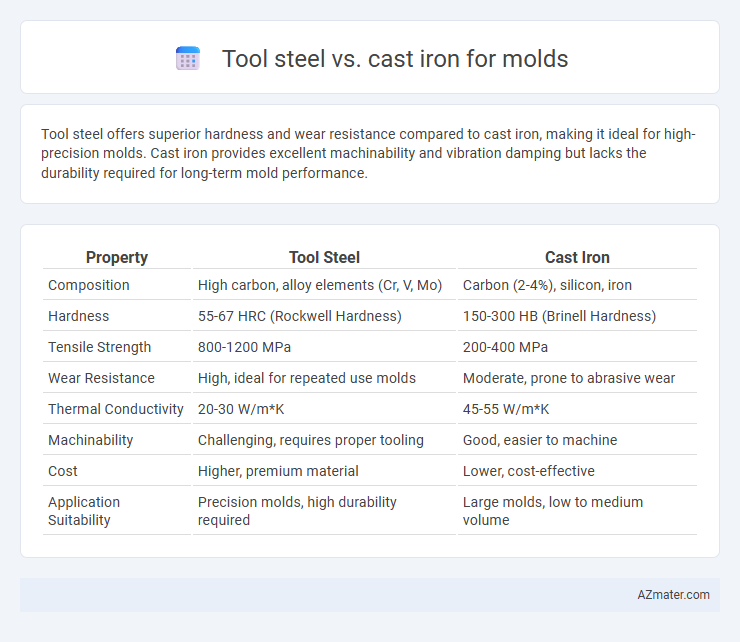Tool steel offers superior hardness and wear resistance compared to cast iron, making it ideal for high-precision molds. Cast iron provides excellent machinability and vibration damping but lacks the durability required for long-term mold performance.
Table of Comparison
| Property | Tool Steel | Cast Iron |
|---|---|---|
| Composition | High carbon, alloy elements (Cr, V, Mo) | Carbon (2-4%), silicon, iron |
| Hardness | 55-67 HRC (Rockwell Hardness) | 150-300 HB (Brinell Hardness) |
| Tensile Strength | 800-1200 MPa | 200-400 MPa |
| Wear Resistance | High, ideal for repeated use molds | Moderate, prone to abrasive wear |
| Thermal Conductivity | 20-30 W/m*K | 45-55 W/m*K |
| Machinability | Challenging, requires proper tooling | Good, easier to machine |
| Cost | Higher, premium material | Lower, cost-effective |
| Application Suitability | Precision molds, high durability required | Large molds, low to medium volume |
Introduction to Tool Steel and Cast Iron for Molds
Tool steel is widely favored for molds due to its superior hardness, wear resistance, and ability to withstand high temperatures during injection molding processes. Cast iron, known for excellent vibration damping and machinability, is commonly used for molds requiring less strength and thermal stress tolerance. Selecting tool steel or cast iron depends on mold application demands, balancing durability, thermal conductivity, and production cost.
Composition and Material Properties
Tool steel contains high carbon and alloy elements such as chromium, vanadium, and molybdenum, providing superior hardness, wear resistance, and toughness essential for mold durability. Cast iron, primarily composed of iron, carbon (2-4%), and silicon, offers excellent castability and vibration damping but lacks the toughness and hardness required for high-precision molds. The selection depends on the mold application, with tool steel preferred for high-stress, wear-intensive environments and cast iron suited for low-stress, cost-effective molding needs.
Strength and Hardness Comparison
Tool steel exhibits significantly higher strength and hardness compared to cast iron, making it ideal for molds subjected to high pressure and repetitive use. Its superior wear resistance and tensile strength ensure prolonged durability and precision in molding processes. Cast iron, while offering good compressive strength and cost-efficiency, generally lacks the toughness and hardness needed for high-performance molds.
Wear Resistance in Mold Applications
Tool steel offers superior wear resistance compared to cast iron in mold applications due to its higher hardness and toughness, making it ideal for high-volume production molds subjected to severe abrasion. Cast iron, while cost-effective and possessing good castability, typically exhibits lower wear resistance and is more prone to abrasive wear and surface degradation under repetitive stress. Selecting tool steel grades such as H13 or D2 enhances mold longevity and dimensional stability in demanding manufacturing environments.
Thermal Conductivity and Heat Resistance
Tool steel exhibits higher heat resistance compared to cast iron, making it ideal for molds subjected to extreme temperatures without deforming or losing hardness. Cast iron offers superior thermal conductivity, allowing faster heat dissipation and reduced cycle times during molding processes. Selecting tool steel ensures durability under thermal stress, while cast iron optimizes cooling efficiency in mold applications.
Machinability and Fabrication Processes
Tool steel offers superior machinability compared to cast iron due to its uniform composition and hardness, enabling precise mold fabrication with smoother finishes. Cast iron, while cost-effective and excellent for damping vibrations, presents challenges in machining because of its brittleness and tendency to produce abrasive dust that wears cutting tools quickly. Fabrication processes for tool steel mold components often involve advanced CNC machining and heat treatment for enhanced durability, whereas cast iron molds typically require casting followed by grinding and limited machining operations.
Cost-Effectiveness and Economic Considerations
Tool steel offers superior durability and wear resistance for mold making, resulting in longer tool life but at a higher initial cost compared to cast iron. Cast iron, with its lower material and machining expenses, provides a cost-effective option for molds requiring less precision and shorter production runs. Economic considerations favor tool steel for long-term investments where mold longevity and performance outweigh upfront costs, while cast iron suits budget-sensitive projects with limited production volumes.
Performance in High-Volume Production
Tool steel offers superior wear resistance and toughness compared to cast iron, making it ideal for high-volume mold production where durability under repeated stress is critical. Its ability to maintain dimensional stability and resist deformation ensures consistent mold precision during extensive manufacturing cycles. Cast iron, while cost-effective and good for lower volume runs, typically falls short in longevity and surface finish quality under continuous high-pressure usage.
Corrosion Resistance and Maintenance Requirements
Tool steel offers superior corrosion resistance compared to cast iron, making it ideal for molds exposed to moisture and corrosive environments. Cast iron is more prone to rust and requires frequent maintenance such as cleaning and application of protective coatings to prevent deterioration. The low maintenance demand and enhanced durability of tool steel molds often justify their higher initial cost in manufacturing settings.
Choosing the Best Material for Mold Longevity
Tool steel offers superior hardness, wear resistance, and thermal stability compared to cast iron, making it ideal for molds subjected to high-volume production and intricate details. Cast iron, while more affordable and having excellent damping properties, is prone to cracking and wear under repeated thermal cycling, limiting its longevity in demanding mold applications. Selecting tool steel enhances mold durability and maintains dimensional accuracy over extended use, crucial for industries requiring consistent product quality.

Infographic: Tool steel vs Cast iron for Mold
 azmater.com
azmater.com